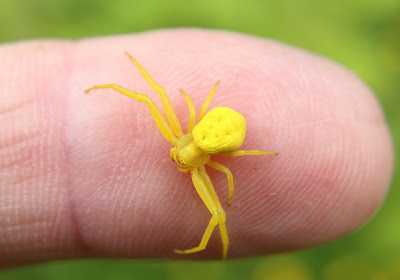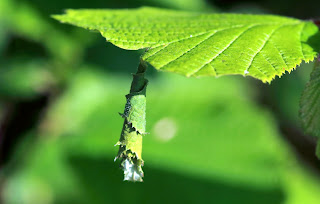CLICK ON ANY IMAGE FOR A LARGER VIEW
I was intrigued as I watched them doing something that seems to be a kind of collective defense mechanism, to warn of potential predators-that is, this 'twitching' movement...
The usual reminder here that you will not see these videos in an e.mailed version of the blog-you will need to visit direct.
Anyhow,I decided that as there were quite a few, I'd take home a small amount to observe and try to photograph through to the butterflies emerging.
By day 7 of watching the caterpillars feeding on fresh nettle that I provided each day, they began to step up their intake...and output come to that, as they began to consume as much as possible before pupation.
Overnight on the seventh and early on the 8th day, they all became golden pupae...
They really are one of nature's many wonders...
And so the constant replacing of food plant and cleaning out of the daily 'frass' had come to an end and now they were to remain motionless until the next stage of metamorphosis was done. Well, no actually! I had read that even at this stage it was possible for movement to be observed and had even seen the occasional twitch myself.
I wasn't prepared for what I witnessed next though....I have never seen this amount of movement before...
This is only a short clip from the video I took, the whole thing is over 10 minutes long and even then, there were other similar bouts during the same day and into the next.
As the time for the butterflies to emerge grew ever closer, the change in colour of the pupae became very noticeable and even the wing colour could be seen...
I set up the camera to try and catch one emerging and began a vigil to ensure I was ready. Several cups of coffee and toilet breaks later, followed by a period of about one hour's uninterrupted close quarter study and my patience was rewarded...
Once again,the video above is only a clip from the original to allow it to load on the blog in a reasonable amount of time. What a magical thing to be able to see at close range though...a real privilege.
There followed a period of twisting and pumping by the butterfly to inflate its wings fully that took quite a while, but eventually it began to resemble the insect we all know...
Eventually it began to exercise its wings in preparation for a maiden flight and I then placed it in the sun to warm itself fully. I took the following photograph, moments before that happened and it disappeared from sight...
I can report that not only did all of the caterpillars I brought home become beautiful small tortoiseshell butterflies, but having released them in a secluded local spot, I have since seen at least one happily sunning itself at the same location.
That's all for this time, until the next update, thanks for your interest,see you again very soon...









































